
The history of Guernsey stretches back with evidence of Neolithic occupation, followed by Roman occupation. Christianity was brought to Guernsey by St Sampson.

A cutter is a name for various types of watercraft. It can apply to the rig of a sailing vessel, to a governmental enforcement agency vessel, to a type of ship's boat which can be used under sail or oars, or, historically, to a type of fast-sailing vessel introduced in the 18th century, some of which were used as small warships.

A pilot boat is a type of boat used to transport maritime pilots between land and the inbound or outbound ships that they are piloting. Pilot boats were once sailing boats that had to be fast because the first pilot to reach the incoming ship got the business. Today, pilot boats are scheduled by telephoning the ship agents/representatives prior to arrival.

The Shetland Bus was the nickname of a clandestine special operations group that made a permanent link between Mainland Shetland in Scotland and German-occupied Norway from 1941 until the surrender of Nazi Germany on 8 May 1945. From mid-1942, the group's official name was the Norwegian Naval Independent Unit (NNIU). In October 1943, it became an official part of the Royal Norwegian Navy and was renamed the Royal Norwegian Naval Special Unit (RNNSU). The unit was operated initially by a large number of small fishing boats and later augmented by three fast and well-armed submarine chasers – Vigra, Hessa and Hitra.
Braye Harbour is the main harbour on the north side of the island of Alderney, in the Channel Islands, a dependency of the British Crown. A 3,000 feet (910 m) breakwater was built by the Admiralty to protect the Navy in the 19th century shelters Braye Harbour. The harbour faces out onto the Swinge, which is part of the English Channel, and it is at Braye that most of the island's freight comes in. Braye is more or less a suburb of St Anne, the island capital; the centre of St Anne lies approximately 1 mile from the harbour.

The military occupation of the Channel Islands by Nazi Germany lasted for most of the Second World War, from 30 June 1940 until liberation on 9 May 1945. The Bailiwick of Jersey and Bailiwick of Guernsey are British Crown dependencies in the English Channel, near the coast of Normandy. The Channel Islands were the only de jure part of the British Empire to be occupied by Nazi Germany during the war. However, Germany's allies, Italy and Japan, also occupied British territories in Africa and Asia, respectively.
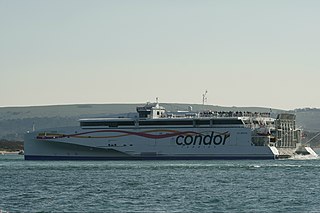
Condor Ferries is an operator of passenger and freight ferry services between The United Kingdom, Bailiwick of Guernsey, Bailiwick of Jersey and France.
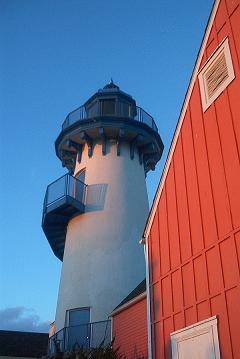
Fisherman's Village is a waterfront mall, commercial boat anchorage and tourist attraction located in the world's largest man-made small boat harbor in Los Angeles County at Marina del Rey, California. The Ballona Wetlands State Ecological Reserve is just east of Fisherman's Village and immediately to the south is the federally-owned riverine estuary of Ballona Creek. The historical Fisherman's Village, built in 1967, is nestled on the eastern bank of main harbor entrance channel between Whiskey Reds restaurant to the south and the Windward boatyard to the north.

Africaine was one of two 40-gun Preneuse-class frigates of the French Navy built to a design by Raymond-Antoine Haran. She carried twenty-eight 18-pounder and twelve 8-pounder guns. The British captured her in 1801, only to have the French recapture her in 1810. They abandoned her at sea as she had been demasted and badly damaged, with the result that the British recaptured her the next day. She was broken up in 1816.
The English Channel naval campaign of the years 1338 and 1339 saw a protracted series of raids conducted by the nascent French navy and numerous private raiders and pirates against English towns, shipping and islands in the English Channel, which caused widespread panic, damage and financial loss to the region and prompted a serious readjustment of English finances during the early stages of the Hundred Years' War. This period was then followed by a French disaster caused by over-confidence and a reversing of roles which had a major effect on the English successes of the next two decades; this result was by no means assured until late 1339 and had the French fought a little longer they might have ended the war before it had really begun.
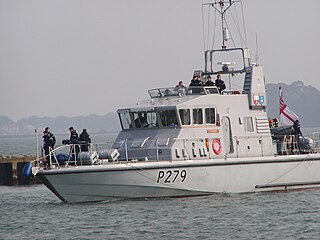
The 1993 Cherbourg incident were a series of maritime incidents which took place from 26 March to 2 April 1993 between the British Royal Navy and French fishermen as a result of a fishing rights dispute in and around the Channel Islands waters.

A Bristol Channel pilot cutter is a type of sailing boat used until the early part of the 20th century to deliver and collect pilots to and from merchant vessels using ports in the Bristol Channel. Each pilot worked individually, in competition with other pilots. Especially after 1861, the level of competition required larger and faster cutters, as pilots went "seeking" at much greater distances. The resulting boats were known for their ability to sail in the most extreme weather, for speed and sea-kindliness. They were designed for short handed sailing, often manned only by a man and an apprentice, with one or sometimes two pilots on board.

During the German occupation of the Channel Islands, there was limited resistance. The islands had a very high number of German soldiers compared to the civilian population, one soldier for every 2-3 civilians, which reduced options; this linked to the severe penalties imposed by the occupiers meant that only forms of non-lethal resistance were used by the population. Even so, over twenty civilians died for resistance against the occupiers.
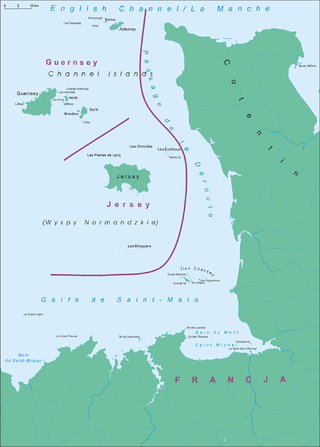
The Channel Islands are a group of islands off the coast of France. The largest island is Jersey, followed by Guernsey, Alderney, Sark, and a number of smaller islands, islets and rocky outcrops. The islands were separated from mainland Europe with rising sea levels in the Neolithic period; thereafter maritime activity commenced.
The evacuation of civilians from the Channel Islands in 1940 was an organised, partial, nautical evacuation of Crown dependencies in the Channel Islands, primarily from Jersey, Guernsey, and Alderney to Great Britain during World War II. The evacuation occurred in phases, starting with school aged children, their teachers, and mother volunteers. The islands and the British military began the evacuation following the Allies' loss in the Battle of France, after which the British Army withdrew from the islands.

The Channel Islands, Crown Dependencies of the United Kingdom, were occupied during the Second World War by Nazi Germany, from 30 June 1940 until May 1945. They were liberated by British forces following the general German surrender.
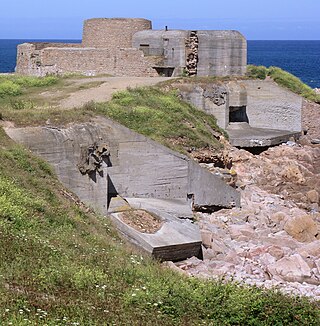
The island of Guernsey has been fortified for several thousand years, the number of defence locations and complexity of the defence increasing with time, manpower and the improvements in weapons and tactics.

Thomas Francis McManus was a fish merchant who became a naval architect, responsible for introducing the shortened bowsprit and long stern overhang to give speed to his vessels. He was well known for revolutionizing the Gloucester fishing schooner. He made the fastest vessels of their type in the world and was honored on two continents for his skill as a naval architect. He became known as the "Father of the Fishermen's Races." 500 fishing schooners used his designs to improve speed. He was a friend of Sir Thomas Lipton and President Theodore Roosevelt.
Rear-Admiral Samuel Jackson was a Royal Navy officer of the eighteenth and nineteenth centuries. Jackson joined the Royal Navy in 1790 and served before the French Revolutionary War in the cutter HMS Kite. He transferred in 1793 to the frigate HMS Romulus, in which he participated in the Siege of Toulon. After having served for a while in the Mediterranean Jackson transferred with the captain of Romulus, John Sutton, to the ship of the line HMS Egmont. In her Jackson fought in 1795 at the battles of Genoa and the Hyères Islands. In 1796, having been promoted to lieutenant and still in Egmont, Jackson was integral in the saving of the entire crew of the ship of the line HMS Bombay Castle off the Tagus during a large storm. In the following year he fought at the Battle of Cape St. Vincent and with Horatio Nelson at the Assault on Cádiz.













